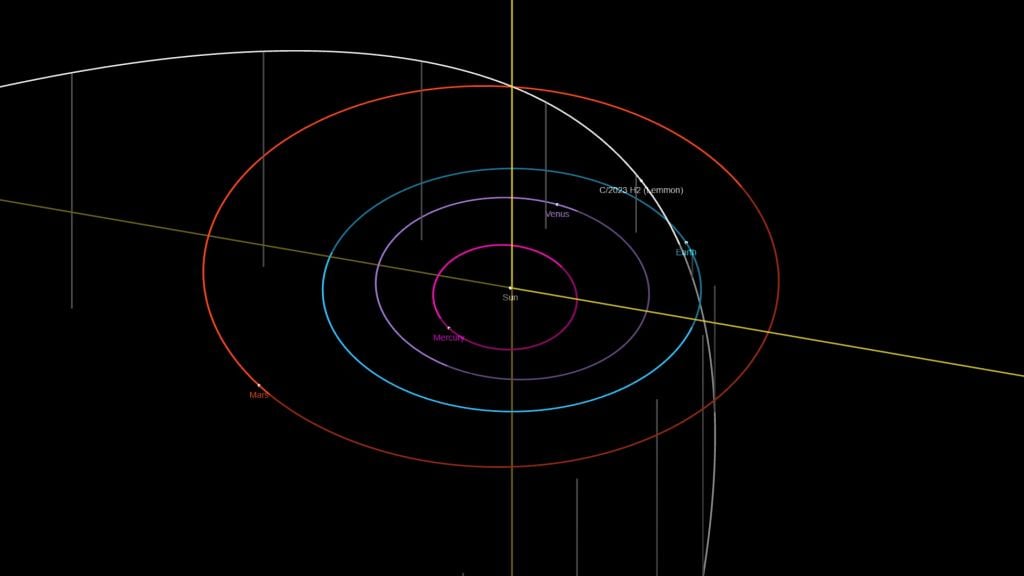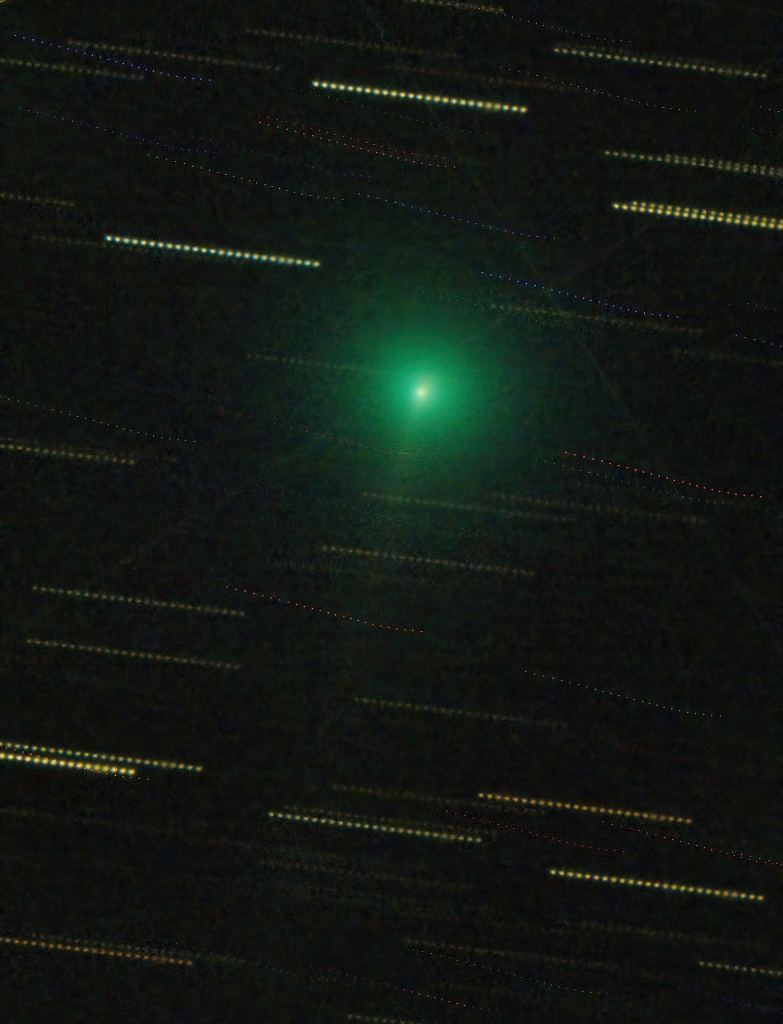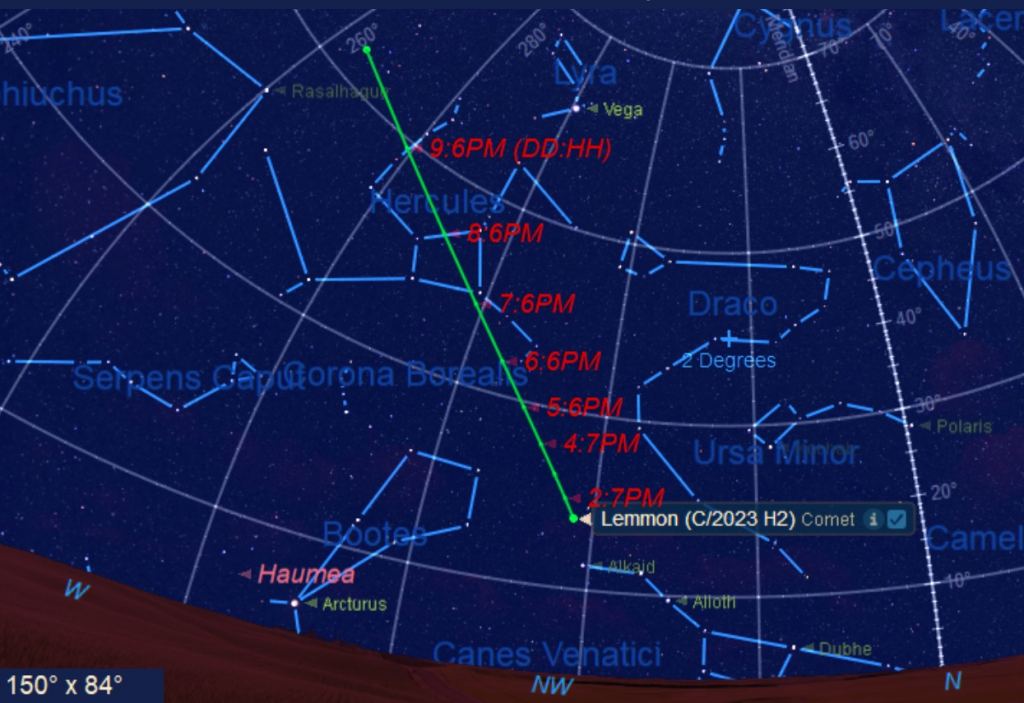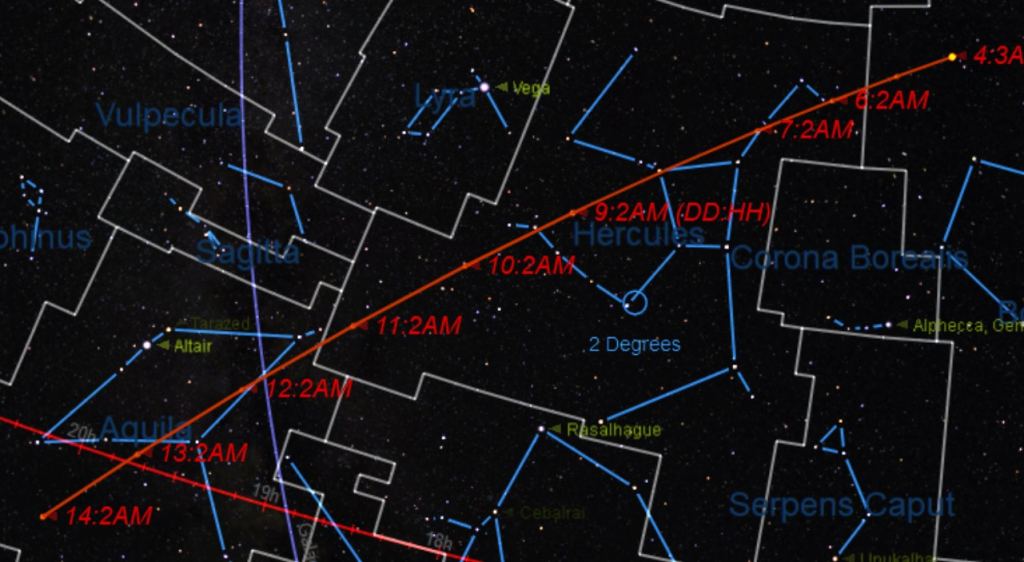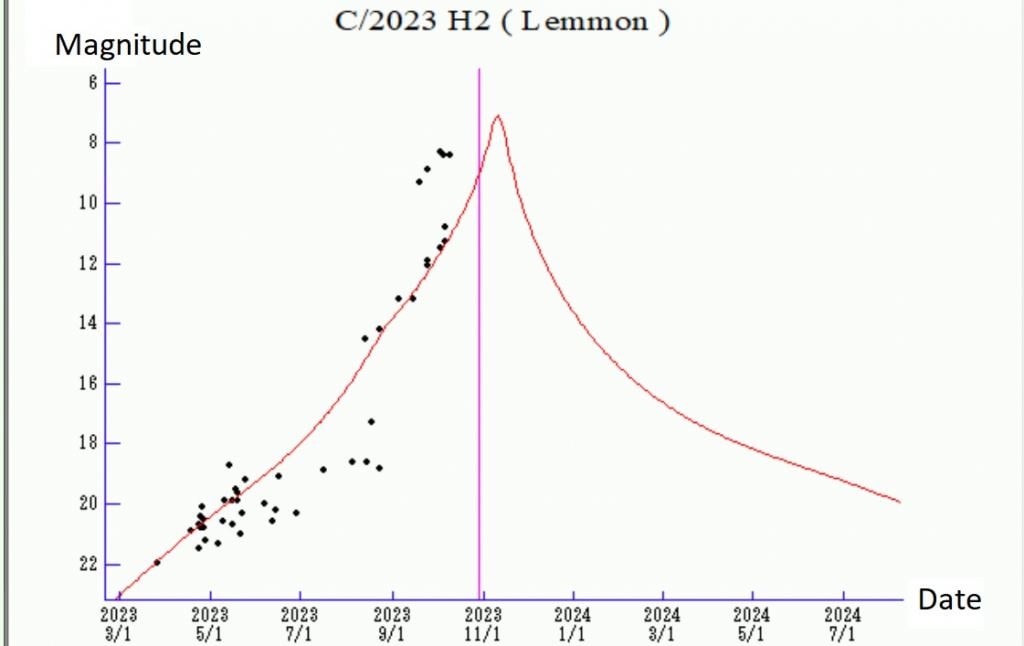Discovered early this year, Comet C/2023 H2 Lemmon may approach naked eye brightness this month.
A comet discovered earlier this year is performing above expectations, and is currently well-placed in the dusk sky. We're talking about Comet C/2023 H2 Lemmon, moving up the charts now at magnitude +8 and brightening.
Comet H2 Lemmon was discovered on the night of April 23rd2023, courtesy of the Mount Lemmon Survey (Part of the Catalina Sky Survey) based outside of Tucson, Arizona. To date, the prolific Mount Lemmon Survey has discovered over 50,000 minor planets, to include comets and asteroids.
The Orbit of Comet H2 Lemmon
Comet H2 Lemmon reached perihelion 0.9 Astronomical Units (AU) from the Sun just inside the Earth's orbit on October 29th. The MOID (Minimum Orbit Intersection Distance) from Earth for the comet is just 0.036 AU (5.4 million kilometers), and the comet is on a long 3,870 year, retrograde orbit, inclined 114 degrees relative to the ecliptic plane.
The orbit was edge on as seen from the Earth earlier this week on October 31st. Often, this is the time when you'll see a spiky 'anti-tail' that seems to extend from the comet nucleus towards the Sun. Comet E3 ZTF exhibited this sort of dramatic phenomenon earlier this year.
The first half of November is the best time to catch comet H2 Lemmon. The comet will really be truckin,' moving at nine degrees a day at closest approach around November 10th. That's about half an angular degree or the diameter of a Full Moon every 90 minutes, a motion versus the stellar background that should be easily discernible after following the comet for about 10 minutes. The comet starts off low to the northwest at dusk for northern hemisphere observers, before vaulting up high through the constellation Hercules into Aquila by mid-month.
Here are the celestial dates with destiny for Comet H2 Lemmon through November. Unless otherwise noted, 'passes near' denotes a passage closer than one degree:
Comet H2 Lemmon in November
6-Crosses into the constellation Hercules.
7-Passes near the +4.2 magnitude star Phi Herculis.
8-Photo Op: Passes near the +4.2 magnitude star Sigma Herculis, and 4 degrees from the globular cluster Messier 13 and 3 degrees from the globular cluster Messier 92.
9-Passes just 10' from the +3rdmagnitude star Pi Herculis.
10-Passes near the +3.7 magnitude star Xi Herculis and passes 0.19 AU from the Earth, perhaps reaching a peak brightness of +5 magnitude.
11-Passes near +4 magnitude star Zeta Aquilae and the +3rdmagnitude star Epsilon Aquilae, and moves in to the constellation Aquila.
12-Crosses the galactic plane southward.
13-Crosses the celestial equator southward.
15-Crosses into the constellation Capricornus.
17-Crosses the plane ecliptic southward.
19-The 45% illuminated, waxing crescent Moon passes less than 4 degrees from the comet.
20-Nicks the corner of the constellation Microscopium.
21-Crosses into the constellation Piscis Austrinus.
29-Crosses into the constellation Grus.
Catching the Comet
Through binoculars, the comet will appear similar to a fuzzy globular cluster that stubbornly refuses to snap into focus. Typically, comets that break +10 magnitude grab our attention as potential photographic and binocular targets worth showing off at star parties. Around +5thor +6thmagnitude, comets begin to become more appealing, as they're approaching naked eye visibility as seen from a good dark sky site.
At about +2ndor +3rdmagnitude, comets start to become truly photogenic targets, bright enough to capture along with foreground objects. Keep in mind that like deep sky objects, all that precious magnitude quoted for comets is smeared out over an extended area. This makes them appear visually fainter than a star of the same brightness. On average, 1 out of 10 comets discovered becomes a good binocular comet, and maybe 1 out of 10 of those goes on to attain naked eye visibility.
What Makes a 'Great Comet?'
Orbits also play a key role as to whether a new comet discovery is destined for greatness or not. A good sign includes a perihelion either near the Earth in the inner solar system. Also, an intrinsic brightness while the comet is still far our in the solar system (suggesting a large bright nucleus) is another hopeful sign. We had two great lessons on this in the late '90s. First was Comet C/1995 O1 Hale-Bopp, a large bright comet that was spotted while it was still far out in the solar system. Then, Comet C/1996 B2 Hyakutake, a smaller comet, crept up on us and passed close to the Earth.
Sometimes even prosaic discoveries can have significance. One example is the recently discovered comet from the same sky survey 2023 S3 Lemmon, which shares some similarities with famous Comet 1P Halley. Comet S2 Lemmon has an orbital period exactly twice as long as Halley's Comet at 152 years.
And speaking of the most famous of all comets, 1P/Halley reaches aphelion next month on December 9that 35 AU from the Sun, out beyond the orbit of Uranus. We're now midway between the last 1986 apparition for the comet, and the next perihelion in (mark your calendars) early 2061.
Comet roll call for 2023 thus far includes Comet 1P/Encke, Comet 103P Hartley, 2023 P1 Nishimura, 2021 T4 Lemmon, 2023 E1 ATLAS, 2022 E3 ZTF. Most of these fell in binocular range, though P1 Nishimura reached magnitude +2 near perihelion in September 2023.
Comet Prospects in 2024
We're certainly due for the next great comet of the century. Looking ahead to next year, comets expected reach perihelion with a magnitude brighter than +10 include:
-12P Pons-Brooks on April 21stat magnitude +3.9;
-13P Olbers on July 1stat magnitude +7.5;
-144P Kushida on January 26that magnitude +7.9;
-2021 S3 PanSTARRS on February 15that magnitude +7.4; and:
-2023 A3 Tsuchinshan -ATLAS on September 28that magnitude +2.5.
12P Pons-Brooks is especially intriguing, as the comet has undergone several outbursts this year, including one this week topping out at magnitude +11. This has given the comet a horseshoe, 'Millennium Falcon' -esque appearance, that has made its rounds on ye 'ole web. Clearly, something interesting is going on on this very active and energetic comet. Along with A3 Tsuchinshan-ATLAS at the end of the year, 12P/Pons-Brooks is worth keeping and eye on. It also reaches perihelion very near the April 8th2024 total solar eclipse spanning North America.
Will we see a naked eye comet near the Sun during totality? It's an intruding possibility for sure… in the meantime, we can enjoy the brief sight of Comet H2 Lemmon, currently gracing November skies.
 Universe Today
Universe Today

